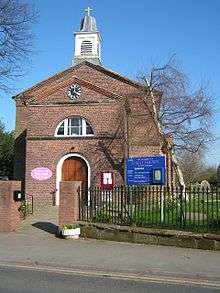Haslington
Haslington is a village and civil parish in the unitary authority of Cheshire East and the ceremonial county of Cheshire, England. It lies about 2 miles (3 km) north-east of the much larger railway town of Crewe and approximately 4 miles (6.5 km) south of Sandbach. The village was originally bisected by the A534 road that links Crewe with Sandbach, however, this road has now been re-routed to bypass the village to the north-west. The village is also a close neighbour to a number of small towns and villages (including Alsager, Wheelock, Winterley), and is approximately 6 miles (9 km) from the Elizabethan market town of Nantwich.
| Haslington | |
|---|---|
 Haslington Hall | |
 Haslington Location within Cheshire | |
| Population | 6,536 (2011 Census)[1] |
| OS grid reference | SJ734558 |
| Civil parish |
|
| Unitary authority | |
| Ceremonial county | |
| Region | |
| Country | England |
| Sovereign state | United Kingdom |
| Post town | Crewe |
| Postcode district | CW1 |
| Dialling code | 01270 |
| Police | Cheshire |
| Fire | Cheshire |
| Ambulance | North West |
| UK Parliament | |
| Website | http://www.haslington.org |
History
Haslington is not mentioned in the Domesday Book of 1086, so it is presumed that either the village came into existence afterwards, or was insignificantly small.[2] The earliest mention of Haslington is in 1256, when it was called "Hesinglinton". The name is possibly derived from the phrase "tun among hazels", or "enclosure amongst hazel trees". Often, with settlement names ending with "tun" or "ton", such as Haslington, this indicates origins of a farm enclosed with a moat or fence.[3] Later variations of the name were 'Halinton'; (1292, 1536), "Hasillinton" (1280), "Haselin(g)ton(e)" (1293 to 1586) and "Hass(e)lyn(g)ton" (1307 to 1432).[4] Alternatively it has been suggested the Haslington's name derives from Thomas de Heslynton, an archer in the King's Bodyguard and a resident of Haslington, however this version of events is often discredited due to de Heslynton's life being after the earliest mentions of the village.[2]
In the reign of Edward I, the Barony of Wich-Malbank (now known as Nantwich) was divided up between the heirs of the last Baron who held that title, William. Haslington was given to Auda Vernon of Shipbrooke, whose descendants included the founder and early residents of Haslington Hall.[5]
During the First English Civil War, on 27 December 1642,(?) there was a skirmish between the Royalists and the Parliamentarians that took place on the southern outskirts of the village at a place called Slaughter Hill. The, Parliamentarians—also known as the Roundheads—won the battle. Local legend says the battle caused the brook nearby to turn red from the blood spilt.[6] A sword was found embedded in the bank of Valley Brook.[6] Although the macabre name Slaughter Hill suggests it may be named after this skirmish, it may be a corruption of "Sloe Tree Hill". Blackthorn (Prunus spinosa), the fruit of which are sloes, can still be found in the hedgerows down the lane named Slaughter Hill, which adjoins with the neighbouring civil parish of Crewe Green.[7]
Governance
Haslington was originally a chapelry within the ancient parish of Barthomley. It was made a separate civil parish in 1866.[8] The parish council has 15 councillors, split between three parish wards: Haslington, Winterley, and Oakhanger.[9][10] Haslington is the largest of the three wards.[11]
From 1974 the civil parish was served by Crewe and Nantwich Borough Council, which was succeeded on 1 April 2009 by the new unitary authority of Cheshire East.[12] Haslington falls in the parliamentary constituency of Crewe and Nantwich,[13] which is represented by Labour MP Laura Smith.[14] Smith defeated Conservative MP Edward Timpson in the 2017 general election. Timpson had previously represented the constituency since a by-election in May 2008, following the death of the long-standing Labour MP Gwyneth Dunwoody,[15] a seat which she had held since the constituency's creation in 1983.
Geography
The area around Haslington is primarily arable land, though also some dairy farms. The land to the east in Oakhanger consists of peat, whereas in the west, clay.[11] There are two main areas of peat: White Moss and Oakhanger Moss, the latter of which being a Site of Special Scientific Interest.[11] The parish of Haslington features 110 miles of hedges, 10,000 trees and 60 public paths.[11] There was an original Haslington Hall that pre-dated the current one, built around 1220, that was moated.[3] The moat and Hall gradually crumbled away and became a mere, which was only filled in the 20th century. The mere was near what is now Mere Street, off Crewe Road.[16] The nearby village of Winterley, within Haslington's parish, is home to Winterley Pool, a modest lake by the roadside of Crewe Road.
Areas of land within Haslington, and also nearby Crewe Green and Crewe, are owned by the Duchy of Lancaster.[17] The Duchy of Lancaster is a royal duchy, which provides income to the monarch; the Duke of Lancaster is Elizabeth II.
Haslington is situated 2 miles (3 km) north-east of Crewe, and 4 miles (6.5 km) south of Sandbach. The route from Crewe to Sandbach used to be straight through the village, until the construction of a bypass (A534) to the north west of the village. Transport links in the form of bus routes connect the village from Crewe to Northwich, Macclesfield and Hanley all passing through the village. Haslington's close proximity to Crewe also means residents have access to Crewe railway station, which has frequent train services to cities such as Manchester and London. Additionally, Haslington is relatively close to the M6 motorway, with junctions 16 and 17 serving Crewe and Sandbach, respectively. A small section of the motorway does actually pass through a sparsely-populated area of the parish to the far east by its border. With its various transport links available, Haslington can be considered a dormitory village.
Demography
Haslington has undergone a large, rapid expansion over the last 25 years, thanks to the redevelopment of Crewe. The 2011 UK census gives the population as being 6,536, of which 3,164 are male, and 3,372 are female. [18] They are living in 2,706 households.[19]
Historically, the population was as given the following table:
| Year | 1801 | 1851 | 1901 | 1951 | 2001 | 2011 |
|---|---|---|---|---|---|---|
| Population | 667 | 1153 | 1791 | 3223 | 6430 | 6536 |
(source: UK and Ireland Genealogy Site and 2011 Census).
Landmarks

Haslington Hall
Haslington Hall is a mainly timber framed building situated to the east of the village. Some of its structure dates back to 1480 but it is principally of 1545 with later additions. It was founded by the Vernon family and, in particular, Admiral Sir Francis Vernon who was involved in defeating the Spanish Armada. Notable more recent residents include Air Commodore Dame Felicity Peake, the first director of the Women's Royal Air Force and the dairy millionaire Tony Vernon.
Hawk Inn

The Hawk Inn is on the main road through the village, and dates from the 17th century; it is a Grade II listed building.[20] The pub boasts carved woodwork both inside and out, including various carved faces and a number of engraved phrases on the exterior beams. The pub was once used for stabling horses and highwayman Dick Turpin supposedly once stayed there.[6]
Old House

Almost directly across from The Hawk Inn is a house, formerly two houses which have had the shared wall demolished in order to form a single dwelling, also dating from the 17th century. It too is a Grade II listed building. While the building is 17th century, the date 1510 is inscribed on a board over the door.[21]
St. Matthew's Church
St. Matthew's Church is a small Anglican church. It was built in two phases: the first phase which is the west part in 1810, and the second phase or east part in 1909.
The west part is a simple, brick built structure, with arched doorway and windows. It also has a small cupola on the nave's gable. The east part is in the Decorated style, designed by Reginald Longden, and has incorporated into it, a seven-light east window.
Community facilities
The village has two primary schools (The Dingle and Haslington Primary). Both schools are part of the Sandbach Education Partnership (SEP) and are feeder schools for Sandbach School and Sandbach High School.[22][23]
The Croft Pre-School is an independent pre-school administered by a parents' committee. It opened in 1981 and operates in the Gutterscroft Centre.[24]
Haslington also has a village hall (The Yoxall Village Hall), St. Matthew's Church Hall and a community centre (Gutterscroft Centre), a dentist, an NHS health centre, a chemist, a doctor's surgery and four churches of various denominations.
Haslington Cricket Club runs four senior and six junior teams, and is situated on the outskirts of the village. In 2014 the 1st XI made headlines worldwide after bowling Wirral C.C. out for just 3 runs, the lowest recorded total in any league cricket for over 100 years.
There is also a Christian Boys Brigade in the village; the company was founded in 1970 and operates from Haslington Methodist Church.
The Millennium Rock is a commemorative stone which is situated on the village green.

Notable people
- Admiral Sir Francis Vernon, active during the time of the Spanish Armada built Haslington Hall in 1545[25]
- William Broome (1689 in Haslington – 1745), an English poet[26] and translator
- Herbert Birchenough (1874 in Haslington – 1942 in Newcastle under Lyme), an English football goalkeeper,[27] who played 167 league games in the Football League
- Air Commandant Dame Felicity Peake DBE (1913–2002), the founding director of the UK's Women's Royal Air Force (WRAF), spent much of her youth at Haslington Hall
- Peter Goodwright (born 1936 in Haslington), an English comedy impressionist,[28] best known as a star of the ITV impressions show Who Do You Do?
See also
References
- "2011 Census Haslington (Ward)". Office for National Statistics. Retrieved 3 July 2015.
- "Origin of the name Haslington". Haslington.org. Retrieved 14 October 2011.
- "Haslington Official Parish Handbook" (PDF). Haslington.org. Retrieved 14 October 2011.
- Dodgson (1970, p. 12)
- Haslington Parish Council (1982)
- "A walk around Haslington" (PDF). Discover Cheshire. Archived from the original (PDF) on 9 April 2011. Retrieved 13 October 2011.
- Walking notes giving a source for name "Slaughter Hill", Cheshire County Council, archived from the original on 29 September 2007, retrieved 16 June 2007
- Youngs (1991, p. 20)
- Haslington parish council who's who, HaslingtonOnline (The Haslington parish council website), archived from the original on 18 April 2009, retrieved 18 March 2009
- Meetings, HaslingtonOnline (The Haslington parish council website), archived from the original on 18 April 2009, retrieved 18 March 2009
- "Haslington Parish Plan 2010" (PDF). CheshireAction.org. Archived from the original (PDF) on 29 March 2012. Retrieved 14 October 2011.
- Cheshire (Structural Changes) Order 2008
- Cheshire County Council: Interactive Mapping: Crewe and Nantwich Archived 1 October 2011 at the Wayback Machine (accessed 27 January 2009)
- Sally Weale (4 July 2017). "The teacher and school cuts protester who became an MP". The Guardian. Retrieved 6 July 2017.
- Profile: Edward Timpson, BBC News Online, 23 May 2008, retrieved 18 March 2009
- Alan Cassey (12 October 2008). "Flooded Mere". Haslington.org. Retrieved 14 October 2011.
- Matthew Taylor (3 May 2013). "7,000 new houses for Crewe outlined in Local Plan alternatives". Crewe Chronicle. Retrieved 13 August 2014.
- Haslington Parish Profile Population, statistics.gov.uk, retrieved 6 November 2015
- Haslington Parish Dwellings, statistics.gov.uk, retrieved 6 November 2015
- Historic England. "The Hawk Inn (1136266)". National Heritage List for England. Retrieved 21 March 2009.
- Historic England. "126 and 124 High Street (1138644)". National Heritage List for England. Retrieved 21 March 2009.
- "Dingle Primary School: Welcome to our School". Dingle.cheshire.sch.uk. 6 October 2015. Retrieved 13 January 2016.
- "Haslington Primary School". Retrieved 13 January 2018.
- "The Croft Pre-School". Retrieved 13 January 2018.
- Discover Cheshire - Walking The Wildside Archived 29 July 2012 at Archive.today
- . Encyclopædia Britannica. 04 (11th ed.). 1911.
- Kent, Jeff (1996). Port Vale Personalities. Witan Books. p. 30. ISBN 0952915200.
- IMDb Database retrieved 8 July 2018
Further reading
- Dodgson, J. McN. (1971), The place-names of Cheshire. Part three: The place-names of Nantwich Hundred and Eddisbury Hundred, Cambridge: Cambridge University Press, ISBN 0-521-08049-5
- Haslington Parish Council (1982), Haslington Official Parish Handbook, Haslington Parish Council
- Scholes, R. (2000), Towns and villages of Britain: Cheshire, Wilmslow, Cheshire: Sigma Press, ISBN 1-85058-637-3
- Youngs, F. A. (1991), Guide to the local administrative units of England. (Volume 1: Northern England), London: Royal Historical Society, ISBN 0-86193-127-0
External links
| Wikimedia Commons has media related to Haslington. |
- Haslington Cricket Club Website
- Haslington Circular Walk (Discovercheshire website)
- Haslington War Memorial, retrieved 8 December 2007
- 1st Haslington Boys' Brigade, retrieved 8 December 2007
- Haslington Methodist Church, archived from the original on 12 December 2007, retrieved 8 December 2007